Edible from root to flower, dandelions possess powerful healing properties. Here’s a guide to using dandelions as both food and medicine.
Using Dandelions: 31+ Recipes & Remedies
Dandelions are pretty much the unofficial mascots for foraging and herbal medicine. They can be found on every continent (except Antarctica) and have tremendous value as food and medicine. They invade lawns, fields, and waste spaces despite every effort to control, contain, and kill them.
Dandelions are survivors, and they pass on a little of that to us when we consume them.
Identifying Dandelions
While dandelions do have a few look-alikes, none of them are toxic. Among the common fakers, you’ll find cat’s ear, chicory, shepherd’s purse, and hawksbeard. Here’s your guide to telling the real thing from the fakers.
This article is part of a series on weed gardens and identifying and using the plants you’ll often find there. For other articles in the series, please click here.
Dandelions are perennials1)Perennial: Any plant that lives for more than 2 years. that grow in a basal rosette.2)Basal Rosette: A circular arrangement of leaves at ground level. You’ll never find leaves growing from the stem. Leaves are anywhere from 2 inches to over a foot (5 to 40 centimeters) long and have jagged teeth.
The jagged pattern of the leaves can vary quite a bit. On some plants, the indentations will go nearly to the midline of the leaf, while others will have fairly shallow teeth. The tips of the teeth tend to point backward, toward the center of the plant. Leaves are virtually hairless at all stages of growth.
By the way, the name “dandelion” is said to come from “dent de lion” or “teeth of the lion.” And depending on who you ask, this either refers to the jagged leaves or the flower petals.
The scientific name, Taraxacum officinale, could be translated as “the official cure for every disorder.”
The yellow blooms are composite flowers. That is, they look like one flower, but are technically a cluster of tiny flowers. The ends of the petals tend to be flat, rather than tapering to a point, and they overlap all the way to the center of the flower. Blooming happens mostly in spring, and again in fall, with sporadic blooming at any time.
These flowers turn into the puffballs that kids love to blow on to make wishes. A single dandelion plant may produce many stems and flowers, but each stem will have only a single flower. The stems are hollow and can range in length from 2 to 18 inches (5 to 45 centimeters).
All parts of the plant contain a white, milky sap. This would normally be a warning sign, but dandelions are an exception to the rule.
You May Also Enjoy:
“How to Not Die While Wildcrafting: 15 Rules for Foraging Safely”
There are even some rather useful applications for this sap, which we’ll get into below. Be aware that dandelion sap has occasionally been reported to cause contact dermatitis in some individuals.
Dandelions can be found throughout the U.S., Canada, and most of the rest of the world, especially around people.
This is another plant that loves us and wants to be near us. You can find them in lawns, fields, pastures, waste spaces, and disturbed ground. They seem to survive everything from drought, to over-picking, to digging, to mowing, to herbicides.
But why would you want to get rid of these happy little guys? They’re beautiful, and they’re trying so hard to help us.
Edible Uses and Dandelion Recipes
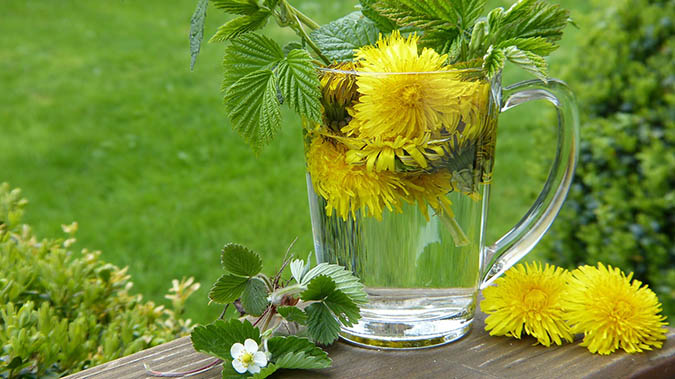
Image by silviarita from Pixabay
If you do an Internet search for dandelion recipes, you’ll find page after page of preparations for this versatile vegetation. Recipes abound when it comes to using dandelions!
I, myself, have only scratched the surface of dandelion delicacies. There are just so many!
Nutritional Value
And why shouldn’t there be? Every part of the plant is edible, raw or cooked. And not only are dandelions plentiful, they’re very nearly a perfect food. Dandelions are rich in potassium; magnesium; manganese; phosphorus; sodium; copper; choline; calcium; iron; lecithin; biotin; inositol; chlorophyll; fiber; and vitamins A, B1, B2, B5, B6, B9, B12, C, D, and E.3)Foster, Steven, James A. Duke, and Steven Foster. A Field Guide to Medicinal Plants and Herbs of Eastern and Central North America. Boston: Houghton Mifflin, 2000.,4)Peterson, Lee Allen, and Roger Tory Peterson. A Field Guide to Edible Wild Plants: Eastern and Central North America. Boston: Houghton Mifflin Company, 1999.,5)Chevallier, Andrew. Encyclopedia of Herbal Medicine. London: DK/Penguin Random House, 2016.,6)Blair, Katrina. The Wild Wisdom of Weeds: 13 Essential Plants for Human Survival. White River Junction, VT: Chelsea Green Publishing, 2014.,7)Gladstar, Rosemary. The Beginners Guide to Medicinal Herbs 35 Healing Herbs to Know, Grow, and Use. Storey Books, 2012.,8)Elpel, Thomas J. Botany in a Day: Thomas J. Elpels Herbal Field Guide to Plant Families. Pony, MT: HOPS Press, 2004.
That’s quite a mouthful. Literally.
You May Also Enjoy:
“12 Uses for Rose Petals—From the Kitchen to the Boudoir (With Recipes)”
They have more vitamin A than any other green plant—six times more than carrots—and a single cup of fresh greens will meet your daily requirement of beta-carotene, iron, calcium, and potassium!9)Blair, Katrina. The Wild Wisdom of Weeds: 13 Essential Plants for Human Survival. White River Junction, VT: Chelsea Green Publishing, 2014.
That tap root really reaches down to bring up the good stuff. You can see why I call them the king of weeds.
Furthermore, when eaten as a whole (roots to flowers/seeds), the dandelion forms a complete protein, with all 9 essential amino acids.10)Blair, Katrina. The Wild Wisdom of Weeds: 13 Essential Plants for Human Survival. White River Junction, VT: Chelsea Green Publishing, 2014. That’s a pretty good trick for a plant.
Dandelion also seems to help with the absorption and balance of minerals.11)Hoffmann, David. Medical Herbalism: The Science and Practice of Herbal Medicine. Rochester, VT: Healing Arts Press, 2003.
Overcoming the Bitter Taste
But let’s address the elephant in the room. Dandelions are bitter. Very bitter. Involuntarily-spit-them-out-and-go-wash-your-mouth-out-with-ice-cream bitter.
Perhaps I exaggerate. But how is one to get past the bitterness to access those amazing nutrients? I’ve got you covered.
First, when using dandelions, you should select the best ones. The best-tasting leaves have had the easiest life. Don’t pick any sunbaked, twice-stepped-on leaves. Harvest from a plant in a shady, well-watered location. Harvest younger greens, earlier in the year. Leaves toward the center of the rosette also tend to be less bitter.
You May Also Enjoy:
“How to Make Homemade Yogurt: Easy, Inexpensive, and the Healthiest You’ll Ever Eat”
Next, choose the right preparation. It’s the rare individual who enjoys eating a handful of dandelion greens raw. Using dandelions is a lot easier when you moderate their taste by chopping them up and mixing them with other greens. They also pair well with savory dishes.
Of all the cooking methods, boiling does the best job of reducing bitterness. Drop the leaves into boiling water for 5 to 10 minutes. If you’ve picked a good plant, it shouldn’t take much more than this. If not, you can always boil them longer. Use plenty of water so the bitterness has someplace to go.
Eating the Roots: Stir-fried, Pickled, and as a Coffee Substitute
The root can be eaten raw, but tastes better when cooked. Try them sliced and stir-fried with other veggies. Cooking breaks down the root’s inulin into fructose, bringing out a much sweeter taste. They’re also a fine addition to soups and stews, and—although I’ve never tried it—they are reportedly quite tasty when pickled.
Dandelion Coffee Recipe
The root is typically harvested from late fall to early spring. Second-year roots are preferred, but good luck on guessing how old a dandelion is by looking at it. If it’s too old and woody to eat, you can still use it to make a caffeine-free coffee substitute.
You May Also Enjoy:
“19 Uses for Spent Coffee Grounds in Your Home and Garden”
“Cold Brew Coffee: Brew the Best-Tasting Coffee Without Fuel”
Slice up the root and slow-roast it in your oven until it turns dark brown and becomes brittle. This should take about 30 minutes at 350°F (175°C).
Let it cool, and then grind it up to use like coffee grounds. I’m usually not a fan of coffee substitutes, but I really enjoy using dandelions this way.
Dandelion Mocha Recipe
If you’d like to take your dandelion coffee to the next level (and who wouldn’t?), you can turn it into a dandelion mocha. This recipe comes from Rosemary Gladstar, and it is delightful.
Use 1 tbsp. each of dandelion coffee grounds and cacao nibs. Simmer in 3 cups of water for 30 minutes. Then strain and add ½ cup milk (or milk substitute), ½ tsp. cinnamon, ½ tsp. vanilla extract, 1 tbsp. honey (or other sweetener), and a dash of ground nutmeg or cloves.
It’s excellent. I highly recommend using dandelions to make mocha!
Using Dandelion Flowers: Sautéed, Fried, and Infused
Dandelion flowers make a colorful addition to salads, soups, ice creams, or just about anything else. Two of my favorite ways to eat them are sautéed in butter and as an ingredient in dandelion lemonade.
- Using dandelions to create sautéed blooms is easy. Just melt some butter and sauté away. (Alternately, you could make a simple egg-and-flour batter and fry them. Yum!)
- To make dandelion lemonade, just add about a quart of dandelion flowers to a half gallon of lemonade. Let the mixture infuse in the fridge overnight, then strain out the blossoms and enjoy.
The less green you have from the base of the blossoms, the less bitter they will taste. Here’s a brief clip demonstrating a super easy way to separate the petals from the bitter greens:
The last way to get past the bitterness inherent in using dandelions is simply to build up an appreciation for it.
Sure, it’s not the most popular option, but you really can develop a taste for a food by consistently consuming small portions of it. Gradually, your aversion turns into tolerance. And then tolerance can even become a craving.
It really works. Try it!
Using Dandelions as Medicine
Dandelion’s medicinal effects are not limited to its impressive nutritional profile. It sports a bevy of benefits. Let’s dive into remedies you can make using dandelions!
Using Dandelions as a Digestive Aid
Dandelion’s bitter taste is likely also its best-known medicinal property. It’s a bitter. Bitters are plants that encourage optimal digestion by stimulating the secretion of enzymes and digestive juices.12)Gladstar, Rosemary. The Beginners Guide to Medicinal Herbs 35 Healing Herbs to Know, Grow, and Use. Storey Books, 2012.,13)Hoffmann, David. Medical Herbalism: The Science and Practice of Herbal Medicine. Rochester, VT: Healing Arts Press, 2003.
You May Also Enjoy:
“15 Natural Antibiotic Alternatives”
Dandelion stimulates appetite, aids the liver in its detoxification duties, helps to regulate the release of pancreatic hormone, is stimulating to the spleen, supports correct bile duct function, and even helps to repair the gut wall.14)Elpel, Thomas J. Botany in a Day: Thomas J. Elpels Herbal Field Guide to Plant Families. Pony, MT: HOPS Press, 2004.,15)Hoffmann, David. Medical Herbalism: The Science and Practice of Herbal Medicine. Rochester, VT: Healing Arts Press, 2003.,16)Mills, Simon, and Kerry Bone. Principles and Practice of Phytotherapy: Modern Herbal Medicine. Edinburgh: Churchill Livingstone, 2013. It may even help to resist the progression of cirrhosis of the liver.17)Mills, Simon, and Kerry Bone. Principles and Practice of Phytotherapy: Modern Herbal Medicine. Edinburgh: Churchill Livingstone, 2013.
Dandelion is a remarkable plant!
Using Dandelions to Treat Colitis
In one experiment, participants with non-specific colitis were given dandelion along with calendula, lemon balm, and St. John’s wort. Complete relief from spontaneous and palpable pains was reported by 96% of participants, and stools were normalized in those with diarrhea symptoms.18)Mills, Simon, and Kerry Bone. Principles and Practice of Phytotherapy: Modern Herbal Medicine. Edinburgh: Churchill Livingstone, 2013.
Using Dandelions as a Spring Tonic and Diuretic
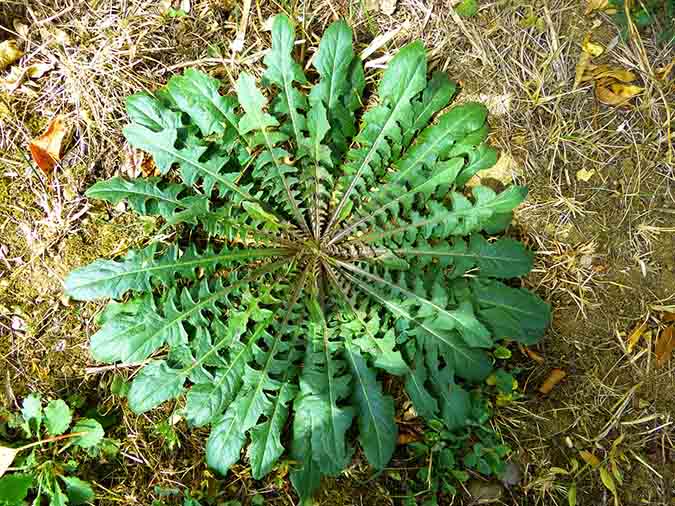
Image by Hans Braxmeier from Pixabay
Dandelion is also well-known as a spring tonic. It helps to flush and tone the body after enduring the rigors of winter.
The entire plant is diuretic, flushing excess water from the body and generally giving us a good cleansing. The leaf is more powerful than the root, and is comparable to the drug furosemide in terms of strength.19)Hoffmann, David. Medical Herbalism: The Science and Practice of Herbal Medicine. Rochester, VT: Healing Arts Press, 2003. Don’t take it right before bed or you’ll be up all night. Trust me. I know.
Dandelion’s diuretic properties help to relieve fluid retention.20)Mills, Simon, and Kerry Bone. Principles and Practice of Phytotherapy: Modern Herbal Medicine. Edinburgh: Churchill Livingstone, 2013. It is also used to dissolve calcium stones and to prevent new ones from forming, and can be used safely over long periods.21)Elpel, Thomas J. Botany in a Day: Thomas J. Elpels Herbal Field Guide to Plant Families. Pony, MT: HOPS Press, 2004.,22)Mills, Simon, and Kerry Bone. Principles and Practice of Phytotherapy: Modern Herbal Medicine. Edinburgh: Churchill Livingstone, 2013.
You May Also Enjoy:
“The 7 Stages of Home Medicine Makers”
Dandelion’s diuretic nature may also help to explain its effectiveness in relieving arthritic complaints.23)Hoffmann, David. Medical Herbalism: The Science and Practice of Herbal Medicine. Rochester, VT: Healing Arts Press, 2003.
With conventional pharmaceuticals, as the body flushes out water, it’s also flushing out our supply of potassium. This can be rough on your heart and cause problems for anyone with a heart condition.24)Hoffmann, David. Medical Herbalism: The Science and Practice of Herbal Medicine. Rochester, VT: Healing Arts Press, 2003. Dandelion, on the other hand, is so rich in potassium that even while it flushes out the body, it still provides a net gain in potassium.25)Chevallier, Andrew. Encyclopedia of Herbal Medicine. London: DK/Penguin Random House, 2016. This makes it an ideal diuretic herb for people with heart issues.26)Hoffmann, David. Medical Herbalism: The Science and Practice of Herbal Medicine. Rochester, VT: Healing Arts Press, 2003.
Using Dandelions for Skin Health
The natural latex in dandelion sap is helpful in getting rid of warts.27)Gladstar, Rosemary. The Beginners Guide to Medicinal Herbs 35 Healing Herbs to Know, Grow, and Use. Storey Books, 2012. However, this is not a quick process. Using dandelions for wart removal requires applying the sap several times a day for 2 to 3 weeks. Direct application of the sap can also help with moles, pimples, canker sores, and other skin blemishes.28)Blair, Katrina. The Wild Wisdom of Weeds: 13 Essential Plants for Human Survival. White River Junction, VT: Chelsea Green Publishing, 2014., 29)Grossberg, George T., and Barry Fox. The Essential Herb-drug-vitamin Interaction Guide: The Safe Way to Use Medications and Supplements Together. New York: Broadway Books, 2007.
Using Dandelions to Fight Cancer and Harmful Bacteria
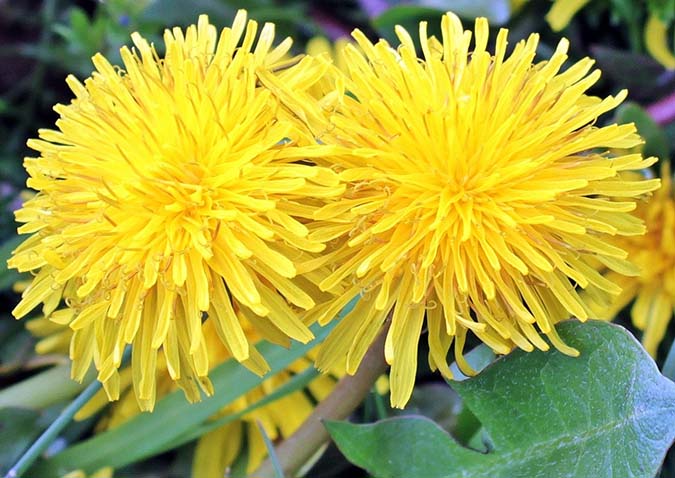
Image by S. Hermann & F. Richter from Pixabay
Dandelion may have anti-tumor/anti-cancer properties, though it is not clear whether this would be from a direct action or indirectly through its ability to cleanse and support normal body function.30)Hoffmann, David. Medical Herbalism: The Science and Practice of Herbal Medicine. Rochester, VT: Healing Arts Press, 2003.,31)Mills, Simon, and Kerry Bone. Principles and Practice of Phytotherapy: Modern Herbal Medicine. Edinburgh: Churchill Livingstone, 2013. Dandelion also appears to have selective antimicrobial properties, supporting healthy gut bacteria while discouraging unhealthy ones.32)Foster, Steven, James A. Duke, and Steven Foster. A Field Guide to Medicinal Plants and Herbs of Eastern and Central North America. Boston: Houghton Mifflin, 2000.,33)Blair, Katrina. The Wild Wisdom of Weeds: 13 Essential Plants for Human Survival. White River Junction, VT: Chelsea Green Publishing, 2014.,34)Mills, Simon, and Kerry Bone. Principles and Practice of Phytotherapy: Modern Herbal Medicine. Edinburgh: Churchill Livingstone, 2013. It even helps prevent plaque buildup on teeth.35)Blair, Katrina. The Wild Wisdom of Weeds: 13 Essential Plants for Human Survival. White River Junction, VT: Chelsea Green Publishing, 2014.
Other Medicinal Uses
Dandelion is also cooling and drying, and can be used as a fever reducer.36)Mills, Simon, and Kerry Bone. Principles and Practice of Phytotherapy: Modern Herbal Medicine. Edinburgh: Churchill Livingstone, 2013. It’s a mild laxative and has an alkalizing effect on the body.37)Elpel, Thomas J. Botany in a Day: Thomas J. Elpels Herbal Field Guide to Plant Families. Pony, MT: HOPS Press, 2004.,38)Hoffmann, David. Medical Herbalism: The Science and Practice of Herbal Medicine. Rochester, VT: Healing Arts Press, 2003.,39)Mills, Simon, and Kerry Bone. Principles and Practice of Phytotherapy: Modern Herbal Medicine. Edinburgh: Churchill Livingstone, 2013. Dandelion may also help some people with allergies and food intolerances.40)Mills, Simon, and Kerry Bone. Principles and Practice of Phytotherapy: Modern Herbal Medicine. Edinburgh: Churchill Livingstone, 2013.
You May Also Enjoy:
Check Out TGN’s Collection of Premium-Quality Herbs!
“How to Make Your Own Tinctures, Salves, and Essential Oils”
In animal studies, dandelion has been shown to have hypoglycemic activities.41)Hoffmann, David. Medical Herbalism: The Science and Practice of Herbal Medicine. Rochester, VT: Healing Arts Press, 2003. This may make it a helpful plant for those with diabetes, but could be a contraindication for those with hypoglycemia.42)Elpel, Thomas J. Botany in a Day: Thomas J. Elpels Herbal Field Guide to Plant Families. Pony, MT: HOPS Press, 2004.,43)Grossberg, George T., and Barry Fox. The Essential Herb-drug-vitamin Interaction Guide: The Safe Way to Use Medications and Supplements Together. New York: Broadway Books, 2007.
Medicinal Formats and Dosages
You can use dandelion via any of the normal methods: fresh, dried, tincture, decoction, infusion, etc. The dried leaves make an excellent addition to green powders.
Outside of some very specific circumstances, dandelion is widely considered to be safe. Recommendations vary from herbalist to herbalist as to how much you should take.
I will present some amounts that I think are reasonable, but you should view them as suggestions, rather than rules when you’re using dandelions. Other quantities/frequencies could be equally valid, depending on your situation.
Root Tincture
1:5 ratio in 60% alcohol. Use 2.5–5 ml, 3 times daily.
Root Decoction
Use 2–3 tsp of root material in 1 cup of water. Simmer for 10–15 minutes. Drink this 3 times a day.
Leaf Tincture
1:5 ratio in 40% alcohol. Use 5–10 ml, 3 times daily.
Leaf Infusion
Pour boiling water over ½ tsp of dried leaf and allow to steep for 10–15 minutes. Drink this 3 times a day.
What Do You Think?
What’s your favorite recipe using dandelions or your preferred method for using dandelions medicinally? Let us know in the comments!
________________
Psst! Our Lawyer Wants You to Read This Big, Bad Medical Disclaimer –> The contents of this article, made available via The Grow Network (TGN), are for informational purposes only and do not constitute medical advice; the Content is not intended to be a substitute for professional medical advice, diagnosis, or treatment. Always seek the advice of a qualified health care provider with any questions you may have regarding a medical condition. If you think you may be suffering from any medical condition, you should seek immediate medical attention. You should never delay seeking medical advice, disregard medical advice, or discontinue medical treatment because of information provided by TGN. Reliance on any information provided by this article is solely at your own risk. And, of course, never eat a wild plant without first checking with a local expert.
This is an updated version of an article that was originally published on April 29, 2019. The author may not currently be available to respond to comments, however we encourage our Community members to chime in to share their experiences and answer questions!
The Grow Network is a participant in the Amazon Services LLC Associates Program, an affiliate program designed to provide a means for our team to earn fees for recommending our favorite products! We may earn a small commission, at no additional cost to you, should you purchase an item after clicking one of our links. Thanks for supporting TGN!

Scott Sexton is a TGN Trailblazer, a highly experimental gardener, an unrelenting weed-eater, and a largely non-profit herbalist (much to his wife’s chagrin). When Scott is not teaching foraging classes, testing out theories in the garden, or grazing in the forest, he can be found at his Facebook page, “A Forager’s Guide to the Zombie Apocalypse.”
References
| ↑1 | Perennial: Any plant that lives for more than 2 years. |
|---|---|
| ↑2 | Basal Rosette: A circular arrangement of leaves at ground level. |
| ↑3, ↑32 | Foster, Steven, James A. Duke, and Steven Foster. A Field Guide to Medicinal Plants and Herbs of Eastern and Central North America. Boston: Houghton Mifflin, 2000. |
| ↑4 | Peterson, Lee Allen, and Roger Tory Peterson. A Field Guide to Edible Wild Plants: Eastern and Central North America. Boston: Houghton Mifflin Company, 1999. |
| ↑5, ↑25 | Chevallier, Andrew. Encyclopedia of Herbal Medicine. London: DK/Penguin Random House, 2016. |
| ↑6, ↑9, ↑10, ↑33, ↑35 | Blair, Katrina. The Wild Wisdom of Weeds: 13 Essential Plants for Human Survival. White River Junction, VT: Chelsea Green Publishing, 2014. |
| ↑7, ↑12 | Gladstar, Rosemary. The Beginners Guide to Medicinal Herbs 35 Healing Herbs to Know, Grow, and Use. Storey Books, 2012. |
| ↑8, ↑14, ↑21, ↑37, ↑42 | Elpel, Thomas J. Botany in a Day: Thomas J. Elpels Herbal Field Guide to Plant Families. Pony, MT: HOPS Press, 2004. |
| ↑11, ↑13, ↑15, ↑19, ↑23, ↑24, ↑26, ↑30, ↑38, ↑41 | Hoffmann, David. Medical Herbalism: The Science and Practice of Herbal Medicine. Rochester, VT: Healing Arts Press, 2003. |
| ↑16, ↑17, ↑18, ↑20, ↑22, ↑31, ↑34, ↑36, ↑39, ↑40 | Mills, Simon, and Kerry Bone. Principles and Practice of Phytotherapy: Modern Herbal Medicine. Edinburgh: Churchill Livingstone, 2013. |
| ↑27 | Gladstar, Rosemary. The Beginners Guide to Medicinal Herbs 35 Healing Herbs to Know, Grow, and Use. Storey Books, 2012. |
| ↑28 | Blair, Katrina. The Wild Wisdom of Weeds: 13 Essential Plants for Human Survival. White River Junction, VT: Chelsea Green Publishing, 2014. |
| ↑29, ↑43 | Grossberg, George T., and Barry Fox. The Essential Herb-drug-vitamin Interaction Guide: The Safe Way to Use Medications and Supplements Together. New York: Broadway Books, 2007. |
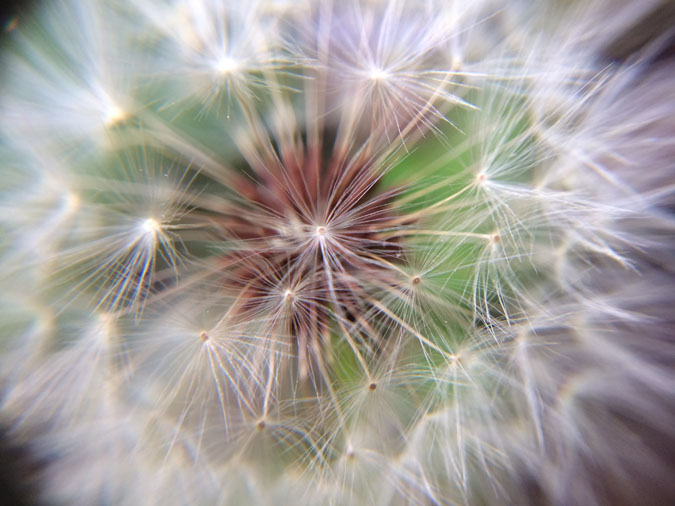
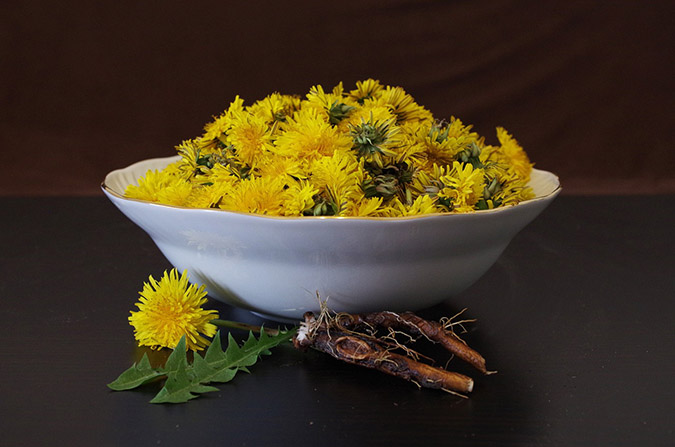
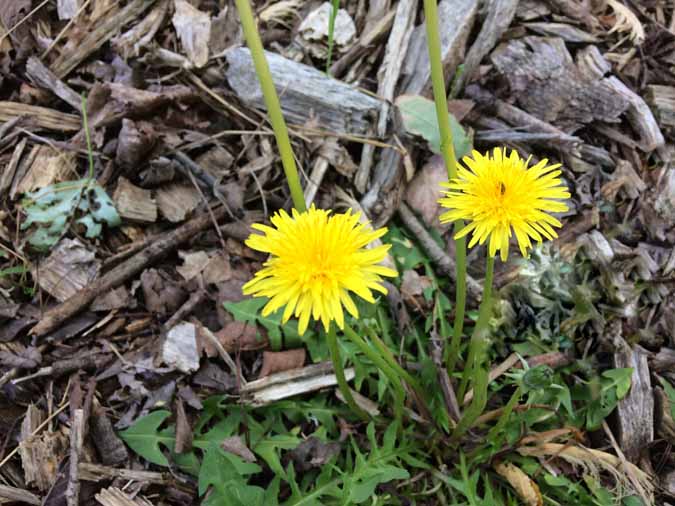
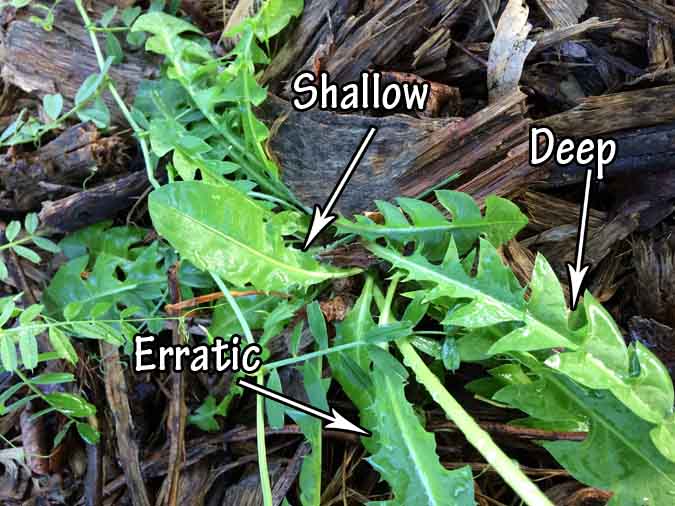
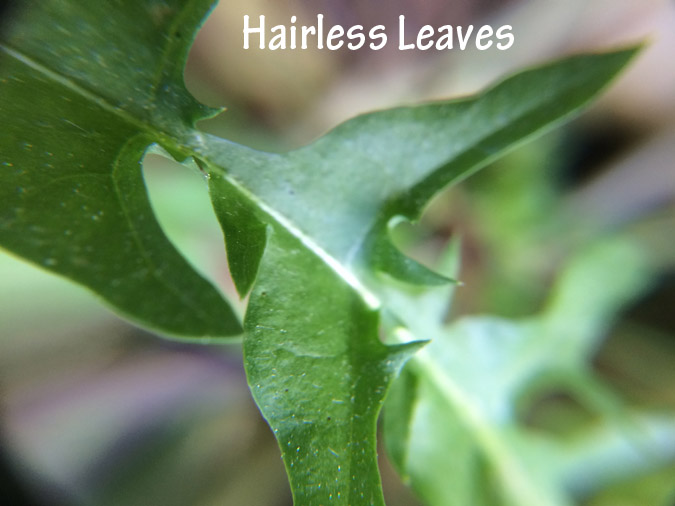
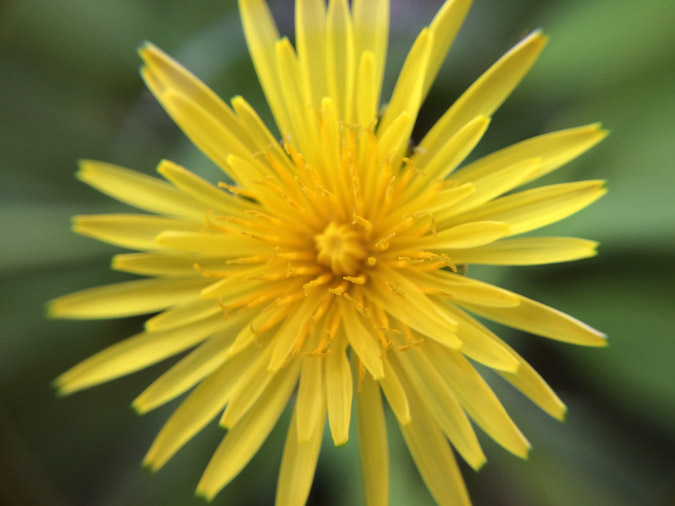
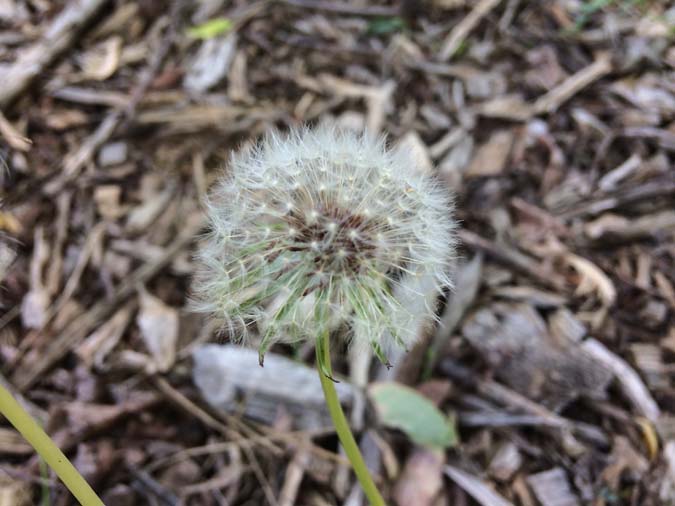
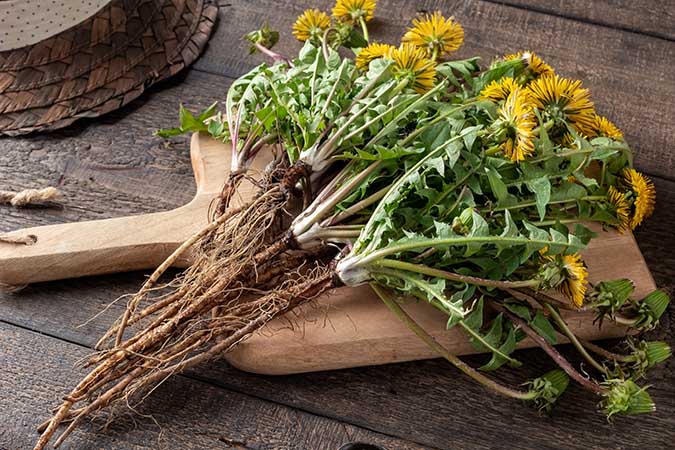
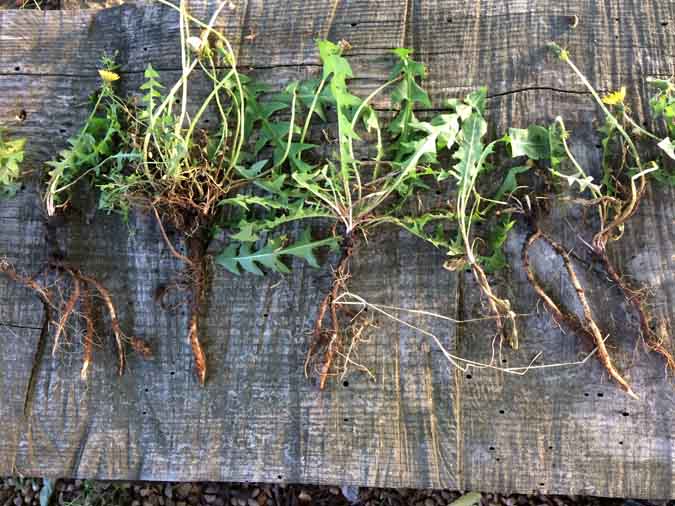

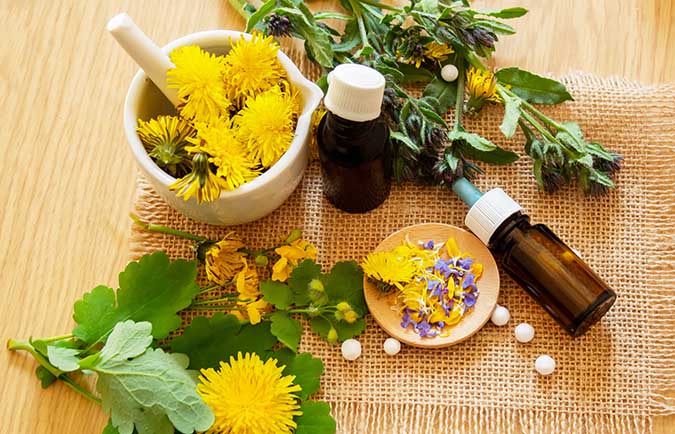
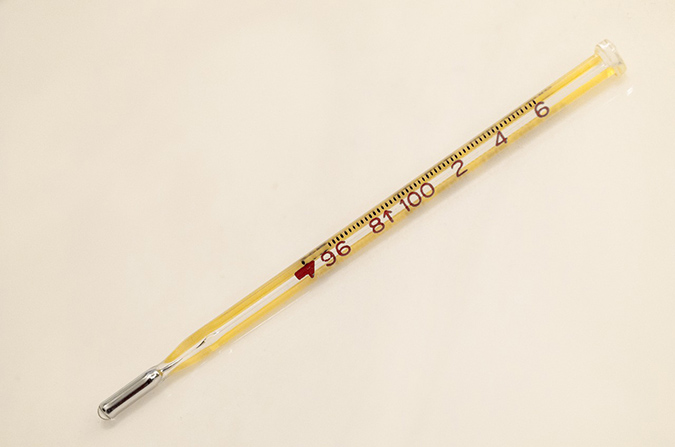
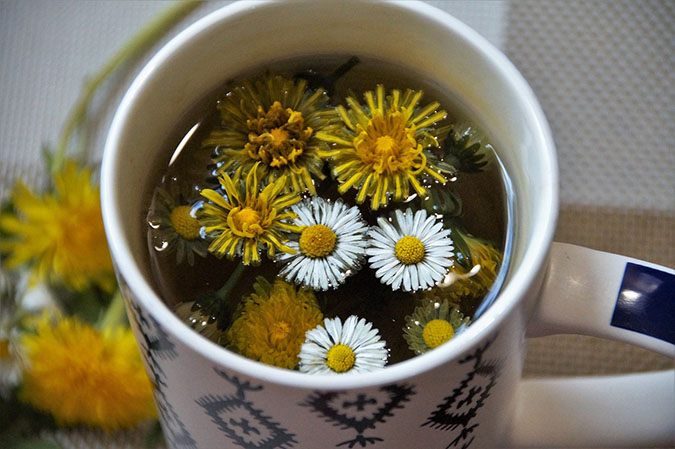







COMMENTS(33)
I love your article Scott! I grew up in a Kansas Home where first thing every Spring our Mom sent us out to collect dandelion greens. I have fond memories of eating these every year! I have been using dandelion root along with peppermint, turmeric and milk thistle to clean up my liver. My liver got blown out in an industrial accident several years ago. My readings since I started this 4 months ago have gone back to normal levels. My doctors have been amazed. This year we are blessed with tons of dandelions so I have everyone out digging them up so I can dry them to use later in the year.
Thanks. I’m glad your liver has improved. Those livers are pretty important things. That’s a good herb mix you have going too. I need to grow some more milk thistle myself.
Enjoy your dandelion bounty, and be sure to try that dandelion mocha recipe.
Scott, thank you so much for this incredibly informative article. I am sorry I don’t have anything to share relative to dandelion use; perhaps I will next Spring (: I reside in Alaska, and i am really excited for the dandelions to show up (; Take care, and thanks again!
Thanks for reading. If your dandelions grow large enough in Alaska, see if you craft one into a flute. I can do it with a straw, but I’ve never gotten it to work with dandelions. Maybe you could come back here and give us a tutorial.
Cherlynn, that is incredibly wonderful that you are experiencing such great results with your dandelion plus remedy. If you dont mind sharing your “recipe” that would be lovely. Take care, and i wish you fabulous health.
Hi Scott, Really good article! SO well researched. I am so stoked that the yard in our Colorado research center has them all over the place. I’ve been giving a few leaves to my family before dinner as a digestive aid. I let them know how important that bitter is for getting their juices going – seems to work 🙂
Thank you so much! I view a yard full of dandelions as a sort of unofficial good luck charm.
I’ve been trying to expand my appreciation for bitter tastes by eating a big handful of dandelion leaves once a day. It’s getting better, but they’re not quite what I would call “good” yet. 😉
Great article Scott! I like your comment about dandelions being the unofficial mascot! I know if I can change someone’s perception about dandelions from being a weed to being food/medicine, it opens the door to soo many other discussions!
Yup. And the better-tasting foods are a good way to do that. Dandelion lemonade or mocha are two winners. It’s hard to win somebody over by handing them a raw dandelion leaf, right? Ha!
Great article! What is the benefit of using dandelions as a tea compared to consuming the entire plant?
That is an excellent question! Thanks, wilmashaw610. As far as taste goes, it’s easy to doctor a tea up to make it more palatable. A splash of milk and a little honey go a long way to making medicinal teas taste better.
Medicinally, things get slightly more complex. When you make a tea, you are extracting primarily those constituents that are water soluble. You’ll still get the medicinal effects by drinking a tea, though the effects may be slightly diminished compared to eating the whole plant. Also, you won’t get the full nutritional benefit as some will still be stuck in the plant material.
On the flip side, if you were to boil dandelion leaves to eat them, you’d have the reverse situation. Those materials that weren’t as easily water soluble would tend to remain, while those materials that were most water soluble would end up poured away.
I wouldn’t really worry either way. You should still have plenty of overlap, with some percentage of the medical properties moving into the water and some staying with the leaf material. And if you need more, just drink more. It’s a very safe plant.
The most potent method would be to consume the leaf raw, or perhaps to parboil it for just a minute or two to help break down the cell walls. Of course that’s a bitter answer (pun intended).
Thanks for the question!
I hear that picking a dandelion in England will cost a Fine 500 Pounds!
Wow! That’s a lot. They must really love their dandelions.
This is what Swedes to with Dandelions…
Dandelion Wine (Maskrosvin)
Do not make the mistake to taste the wine after only about 1 year, it does NOT taste good, I can promise. Open after a few years and it is very good, reminicent of a sweet sherry.
It can get up to 22 % alcohol content…
ingredients
3 l. Dandelions (just the yellow flowers, with NO green ! )
4 l. Water
3 sliced lemons
1.7 – 4 kg (3.8 – 8.8 lbs) of sugar (the more sugar = longer ferment = stronger…)
Instructions
Boil the water and pour over the dandelions. Leave for 12 hours. Strain out the flowers.
Stir in the sugar and put in the lemon slices. Pour into a stainless steel bucket. land leave for 2-3 weeks with cloth over. Look at the wine every day. When the yeast (naturrally ocurring on the flowers) has stopped its fermenting process, fill bottles and leave for a couple of years in a cool place. YES – A COUPLE OF YEARS!!
Thanks for the tips. I’m sure we’ll benefit from your info.
Wonderfully informative article, Scott! My question: What do you find is the best way to clean the leaves on this plant before adding to a salad? Because the leaves are close to the ground, the leaves always have dirt on them, as well as mite size bugs. I don’t want to boil the leaves because they’d lose their nutritional value, as I understand. I’ve tried just soaking them in water and letting everything rise to the top and then throwing out the water. Is there a better way? Thanks, Julie
I’m not very squeamish about eating wild things, including the dirt and tiny bugs they come with. Much of the time, I’ll eat plants straight from the ground. So I may not be the best person to ask. When I do wash them off, they usually just get a brief rinse in the sink.
The easiest way I found to clean the whole plant is to put them in a spaghetti strainer after harvesting the plant(s) and then blast them with the hose. I use the single stream setting so it comes out fast like a power washer. It works great to clean up the whole plant quickly and easily. Some times it’s easier to break apart the roots to get the dirt that gets wedged in where they meet. If you’re just eating the leaves you’re missing out. The roots are tasty. Give them a try. I use the smaller roots for eating and the bigger parts for making dandelion coffee (caffeine free).
I am wondering, if I could add Dandelions to my juicing? Given that they are so very packed with all that vitamin goodness and amino acids and all… 🙂
Hi Sandra. Sure, you can juice dandelions. You’ll probably want to start with a small amount until you get a feel for balancing the flavor.
LOL!!! “Involuntarily-spit-them-out-and-go-wash-your-mouth-out-with-ice-cream bitter.”… That was funny!!! Great article with some great bits of humor thrown in. Great comments too, I am intrigued by the Maskrosvin aka Dandelion Wine (thank you Chris)… I did a little searching (yes, they really do collect a ton of flowers and pull the petals off by hand until they have 3 liters/quarts)… There are videos of people doing this and I came across one article with recipes (including a recipe for Dandelion Flower Cookies at the bottom of the page)
https://commonsensehome.com/dandelion-wine-recipe/
I’m going to see if I can find a decent location to pick dandelion flowers and make a batch of wine. It just seems like a fun thing to try and my 5 year old already loves picking dandelion flowers anyway, and he will likely enjoy separating the petals into a colorful yellow pile. Some people might think I’m weird, but I like seeing yellow dandelions in lawns, they are flowers, and they look good, and they pretty darned useful to boot.
Thanks for the inspiration and added appreciation of dandelions Scott.
The pioneers used to make dandelion wine. The tradition was to open the first bottle on Christmas Day. They called it “bottled sunshine”
My mother always gathered young dandelion leaves and added them to our salad. When they are young, they are no more bitter than endive, radicchio, or chicory- all of which are considered “gourmet” greens.
I have a question: I’ve always been interested in making the coffee substitute. Is there any special preparation of the roots, like scraping them or something?
thanks scott great information i was mixing up wild lettuce and dandelions first but i know the difference now
I love dandelions and please do leave them in the lawn for the bees. We need to keep the bees alive if we want to survive. I pick the flowers and make a golden syrup that tastes like herbal honey. I also sprinkle flowers in salad, cookie dough, pancakes, etc. When I go outside I always try to pick one leaf to munch on, yes it’s bitter but that bitterness amps up our immune system…so maybe it’s good to “be tough” for a minute? So much is the mindset.
Thank you Scott, I love dandelions and besides using them in many ways fr salads, stir fries, etc, I have been using the fowers for years in my kombucha, instead of fruits as a second ferment. One of my favorite flavors!
Oh my goodness! Dandelion kombucha? That sounds awesome! That’s going on my to-do list. Thanks!
Scott, Thank you for this very thorough article. I pop about 10 dandelion flowers in my mouth together and chew them like gum. Love it.
There are so many ways to use dandelions. I love hearing everyone chip in with all these different ideas. And I’ll definitely need to try this one. Thanks!
Great Article! You know, if you ever have time to put together an article on the other species in this plant family (ei hawksbeard and many others, for example). I would absolutely love it. I live in FL and we don’t have dandelions in my area but we have other varieties and I have a hard time differentiating them. Thanks for all you do.
Growing up in the spring we ate, what we called dandelion salad, which is potato salad with bacon and dandelions in it. Heavy on the dandelions and bacon. My dad made a blend of miracle whip, sugar, milk, vinegar to go over the salad. We loved it!
Dandelion is one out of three plants that saved my life….my grandfather who was an herbalist, got me out of an orphanage at age 6. He wasn’t sure I would make it, since I was in pretty bad shape, just skin and bone, kids called me skeleton, not able to eat or digest anything. He started giving me a loose oatmeal with fresh dandelion leaves, and fresh nettle soup in a delicious broth. I was able to get down a spoon at a time, in a couple of months I was able to eat a whole small bowl at a time. It sure is a little bitter, but just like with coffee, you get used to the taste and now I crave the Dandelions! Living in a City now I don’t trust picking them here since everyone here spray poison, but if I find them in the wild I pick them. I learned so much growing up with herbs. Still my favorite flower!
I eat a dandelion leaf each time I go out to the garden…so I suspect the benefits will add up over time as I’m outside often. I also love making golden syrup with dandelion heads. However, if you have grass allergies processing (handling, cleaning, drying) can bring on some allergy symptoms. I get pretty stuffy!
I’ve been eating plenty of dandelions the past few years. I grow them in my garden every year now. I grow them as a lettuce substitute for when I’m eating tacos. I put them (flowers, leaves, and small roots) in my pancakes after reading about dandelion bread. I also like roasting up the roots for dandelion coffee. I stopped drinking coffee years ago so it’s nice to have a caffeine free drink that is similar to coffee. I had kidney stone a few years ago, and I certainly don’t want to get one again, so I keep eating dandelions for my kidney health and I know that they are good for my liver as well.